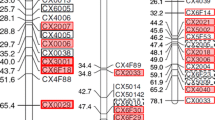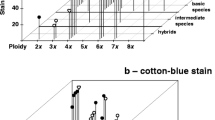Abstract
Microscopic examination, amplified fragment length polymorphism (AFLP) and SCAR (sequence-characterized amplified region) molecular markers were employed to determine the incidence of 2n pollen (unreduced pollen) in Chinese white poplar (Populus tomentosa Carr.) and to identify related molecular markers. The presence of a parallel and tripolar spindle at metaphase II and the absence of cytokinesis at telophase II were found to be determining factors in 2n pollen formation. A group of 298 clones that originated from their indigenous areas were investigated for the production of 2n pollen based on pollen size differences, both within a clone and between n and 2n pollen. Pollen grains were collected from 224 of the clones, six of which were subsequently determined to produce only normal pollen; the remainder produced 2n pollen at different frequencies (0.6–21.9%). The frequency at which 2n pollen was produced was significantly and highly significantly different among and within indigenous populations, respectively. Clones produced by the six normal and twenty-two 2n pollen clones were selected for AFLP analysis. Following an initial screening with 55 primer combinations, the E50-M38 (CAT/ACT) primer was identified: it generated a PCR fragment (246 bp) from the normal clones, but not from the 2n pollen producers. In addition, the E31-M50 (AAA/CAT)-amplified DNA fragment (204 bp) was present in 2n pollen producers, and absent in normal clones. These two discriminating AFLP markers were developed into easily detectable SCAR (sequence characterized amplified region) markers which can be used in combination with previously developed AFLP markers to distinguish between normal and 2n pollen clones.




Similar content being viewed by others
References
Barcaccia G, Albertini E, Rosellini D, Tavoletti S, Veronesi F (2000) Inheritance and mapping of 2n-egg production in diploid alfalfa. Genome 43:528–537
Barcaccia G, Tavoletti S, Pezzotti M, Falcinelli M, Veronesi F (1994) Fingerprinting of alfalfa meiotic mutants using RAPD markers. Euphytica 80:19–25
Barcaccia G, Tavoletti S, Falcinelli M, Veronesi F (1997) Environmental influences on the frequency and viability of meiotic and apomeiotic cells of a diploid mutant of alfalfa. Crop Sci 37:70–76
Barcaccia G, Varotto S, Meneghetti S, Albertini E, Porceddu A, Parrini P, Lucchin M (2001) Analysis of gene expression during flowering in apomeiotic mutants of Medicago spp.:cloning of ESTs and candidate genes for 2n eggs. Sex Plant Reprod 14:233–238
Bradshaw HD, Stettler RF (1993) Molecular genetics of growth and development in Populus. I. Triploidy in hybrid poplars. Theor Appl Genet 86:301–307
Calderini O, Mariani A (1997) Increasing 2n gamete production in diploid alfalfa by cycles of phenotypic recurrent selection. Euphytica 93:113–118
Hermsen J G Th (1984) Mechanisms and genetic implications of 2n-gamete formation. Iowa State J Res 58:421–434
Jacobsen E (1976) Cytological studies on diplandroid production in a dihaploid potato clone and its correlation with seed set in 4x-2x crosses. Z Pflanzenzuechtg 77:10–15
Kang XY (2002) Mechanism of 2n pollen occurring in Chinese white poplar. J Beijing For Univ 24:67–70
Kang XY, Zhu ZT (1997) A study on the 2n pollen vitality and germinant characteristics of white populus. Acta Bot Yunnanica 19:402–406
Kang XY, Zhu ZT, Lin HB (1999) Study on the effective treating period for pollen chromosome doubling of Populus tomentosa × P. bolleana. Sci Silvae Sinicae 35:21–24
Kang XY, Zhu ZT, Lin HB (2000) Radiosensitivity of different ploidy pollen in poplar and its application. Acta Genet Sinica 27:78–82
Kang XY, Zhu ZT, Zhang ZY (2000) Suitable period of high temperature treatment for 2n pollen of Populus tomentosa × P. bolleana. J Beijing For Univ 22:1–4
Li XG, Zhu ZT, Su FW, Zhang YH (1996) Genetic diversity study on morphological characteristics of plus tree gene resources of Populus tomentosa. J Jilin For Univ 12:14–18
Mashkina OS, Burdaeva LM, Belozerova MM, Vyunova LN (1989) Method of obtaining diploid pollen of woody species. Lesovedenie 1:19–25
Murray MG, Thompson WF (1980) Rapid isolation of high molecular weight DNA. Nucleic Acids Res 8:4321–4325
Parrott WA, Smith RR (1986) Recurrent selection for 2n pollen formation in red clover. Crop Sci 26:1132–1135
Ramanna MS (1974) The origin of unreduced microspores due to aberrant cytokinesis in the meiocyte of potato and its genetic significance. Euphytica 23:20–30
Seitz FW (1954) The incidence of triploid after self-pollination of anomalous and rogynous flowers of a grey poplar. Z Forstgenet 3:1–6
Tavoletti S, Pesaresi P, Barcaccia G, Albertini E, Feronesi V (2000) Mapping the jp (jumbo pollen) gene and QTLs involved in multinucleate microspore formation in diploid alfalfa. Theor Appl Genet 101:372–378
Tixier MH, Sourdille RM, Leroy P, Bernard M (1997) Detection of wheat microsatellites using a non radioactive silver-nitrate staining method. J Genet Breed 51:175–177
Veilleux R, Mchale NA, Lauer FI (1982) 2n gametes in diploid Solanum: Frequency and types of spindle abnormalities. Can J Genet Cytol 24:301–314
Veilleux R (1985) Diploid and polyploid gametes in crop plants: mechanisms of formation and utilization in plant breeding. Plant Breed Rev 3:253–288
Vos P, Hogers R, Bleeker M, Reijans M, Van De Lee T, Hornes M, Frijters A, Pot J, Peleman J, Kuiper M, Zabeau M (1995) AFLP: a new technique for DNA fingerprinting. Nucleic Acids Res 3:4407–4414
Yao CL, Pu JW (1998) Timber characteristics and pulp properties of the triploid of Populus tomentosa. J Beijing For Univ 20:18–21
Zhu ZT, Lin HB, Kang XY (1995) Studies on allotriploid breeding of Populus tomentosa B301 clones. Sci Silvae Sinicae 31:499–505
Zhu ZT, Kang XY, Zhang ZY (1998) Studies on selection of natural triploid of Populus tomentosa. Sci Silvae Sinicae 34:22–31
Acknowledgements
The authors thank Dr. G. Hazenberg for critical reading of the manuscript. The Guan County nursery garden of Shandong province provided the plant material. The research was supported by the National Natural Science Foundation of China (grant no. 30471407) and the Graduate Student Foundation of Beijing Forestry University (grant no. 04jj008).
Author information
Authors and Affiliations
Corresponding author
Rights and permissions
About this article
Cite this article
Zhang, Z., Kang, X., Zhang, P. et al. Incidence and molecular markers of 2n pollen in Populus tomentosa Carr.. Euphytica 154, 145–152 (2007). https://doi.org/10.1007/s10681-006-9280-7
Received:
Accepted:
Published:
Issue Date:
DOI: https://doi.org/10.1007/s10681-006-9280-7




